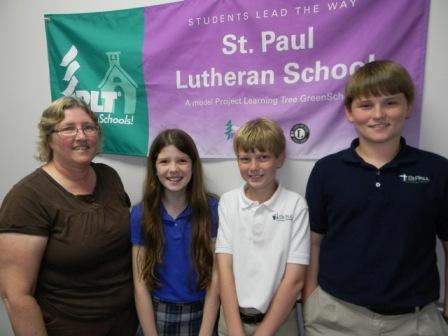 As a Florida PLT school, each class at St. Paul Lutheran, from preschool through grade 8, is involved in at least five PLT activities a year, many of which are conducted in outdoor classrooms.
As a Florida PLT school, each class at St. Paul Lutheran, from preschool through grade 8, is involved in at least five PLT activities a year, many of which are conducted in outdoor classrooms.
Building on that strong base, in 2010 the school helped pilot the national PLT GreenSchools program.
Energy Investigation
The student Green Team established a goal to reduce energy consumption for the school facility by 15%. Fifth-grade students, known as the “Electric Cops,” monitor classrooms to make sure doors are kept closed when the air conditioning is on and lights are turned off when a classroom is not in use. They prepared a school-wide graph for a bulletin board to chart each class’s progress.
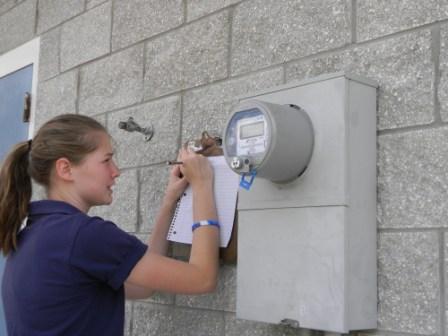 Classroom air-conditioning units now have “energy miser” equipment, and new energy-efficient computers were ordered for the computer lab. Students campaigned to get the school to share the cost with a PLT GreenWorks grant to switch florescent light bulbs in one building to STAR energy-saving light bulbs. They are now raising money to do the same for other buildings.
Classroom air-conditioning units now have “energy miser” equipment, and new energy-efficient computers were ordered for the computer lab. Students campaigned to get the school to share the cost with a PLT GreenWorks grant to switch florescent light bulbs in one building to STAR energy-saving light bulbs. They are now raising money to do the same for other buildings.
Energy education is part of the curriculum. For example, the 5th grade learns about alternative energy and 6th graders complete a unit examining the advantages and disadvantages of different renewable and nonrenewable energy sources. Middle school students have competed in the Florida Solar Energy Whiz and Innovations competition.
Waste & Recycling Investigation
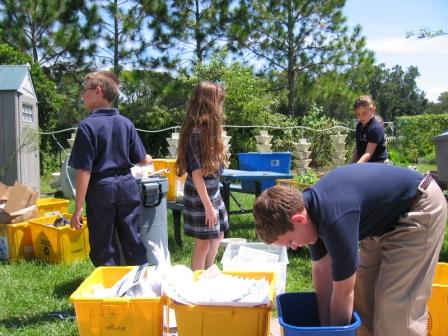 Through recycling, the school decreased its trash output in a school year by one-half of a dumpster, resulting in a savings of $225. The school has compost bins and worm bins, along with a yard waste compost area. The school’s learning standards relate to waste reduction and recycling, and the entire school cooperates with weekly recycling efforts.
Through recycling, the school decreased its trash output in a school year by one-half of a dumpster, resulting in a savings of $225. The school has compost bins and worm bins, along with a yard waste compost area. The school’s learning standards relate to waste reduction and recycling, and the entire school cooperates with weekly recycling efforts.
To encourage reuse, the school has a Swap Day where students can bring items they no longer want to swap with other students. Any extra items are donated to charitable organizations.
Recently, students competed in Keep America Beautiful’s Recycling Bowl. The classes weighed and charted the amount of paper, aluminum cans, plastic bottles, and steel cans they collected and recycled. They have also worked with TerraCycle, which provides free waste collection programs for hard-to-recycle materials such as juice pouches and other food packaging. The Green Team hosted a Monster Mash Candy Wrappers for Cash competition at Halloween.
Students use the money they raise from recycling efforts to stock ponds to help encourage more wading birds to return to the campus.
Water Investigation
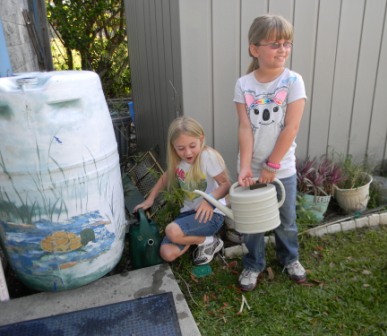 Students check faucets, toilets, and water fountains for leaks to make sure water is not being wasted. Rain barrels are used to irrigate gardens, flowerbeds, and other areas on campus. Fifty-five gallons of water are collected daily from condensation from the metal roofs.
Students check faucets, toilets, and water fountains for leaks to make sure water is not being wasted. Rain barrels are used to irrigate gardens, flowerbeds, and other areas on campus. Fifty-five gallons of water are collected daily from condensation from the metal roofs. 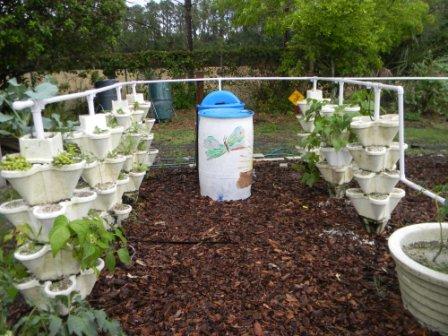 The gardens use hydroponics and drip irrigation, and SoxxTM to reduce water run-off and help stop erosion.
The gardens use hydroponics and drip irrigation, and SoxxTM to reduce water run-off and help stop erosion.
The water cycle and conservation is part of the 2nd and 3rd grade curriculum. State and national water education curricula are used with students, and literature connections play a huge role in student learning. Many grade-level appropriate books are incorporated into the lessons. Water Odyssey, a computer program created by Water Management districts, is used with grades 3, 4, and 5.
School Site Investigation
Every week, students work on the many gardens on the campus: butterfly, bird, vegetable, herb, fruit, flower, and native plants, as well as literature gardens. The gardens use water from rain barrels, drip irrigation, and other water conservation methods, and they provide kindergarteners through fourth-graders a variety of opportunities for math, science, and health lessons.
When parents and church members tour the gardens, they can read pamphlets that describe the plants grown, why they were selected for the local area, and how they provide wildlife with food or shelter. Interpretive/educational signs about watersheds have been posted on campus.
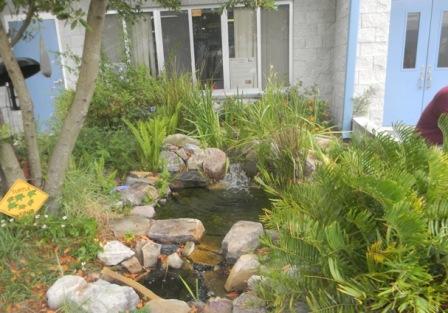 Students helped design and build a turtle and rain garden as an action project associated with their GreenSchool findings. A nearby gutter and downspout provide the water source for the pond. For the wetland garden, students in grades 4 and 5 surveyed their peers, parents, faculty, and community members for suggestions. Students had leadership opportunities from the beginning, participating in almost all areas of the project—from planning pond design, to planting seeds, to making presentations to other classes in the school. Students also learned to work with community partners, such as the local Extension Office and the Lakeland Garden Club. These partners helped students and faculty learn about selecting and planting native plant species. Students presented this project as part of a webinar for the national PLT office.
Students helped design and build a turtle and rain garden as an action project associated with their GreenSchool findings. A nearby gutter and downspout provide the water source for the pond. For the wetland garden, students in grades 4 and 5 surveyed their peers, parents, faculty, and community members for suggestions. Students had leadership opportunities from the beginning, participating in almost all areas of the project—from planning pond design, to planting seeds, to making presentations to other classes in the school. Students also learned to work with community partners, such as the local Extension Office and the Lakeland Garden Club. These partners helped students and faculty learn about selecting and planting native plant species. Students presented this project as part of a webinar for the national PLT office.
When a new road was constructed nearby, many trees were removed and students observed a loss of wildlife as a result. They designed a habitat restoration program using native plants to provide food, water, and shelter to encourage birds and small animals to return to the area. This new area has been certified by the National Wildlife Federation’s Schoolyard Habitat program.
Students in 4th grade and 4-H have partnered with Cornell University to pilot a new curriculum and conduct a bird study. Methods learned from these lessons encouraged the school to plant special plants for the birds’ shelter and food, and new bird boxes have been built and placed in strategic locations. Students take part in a Backyard Bird Count and keep a school list of the birds that visit the campus.
Environmental Quality Investigation
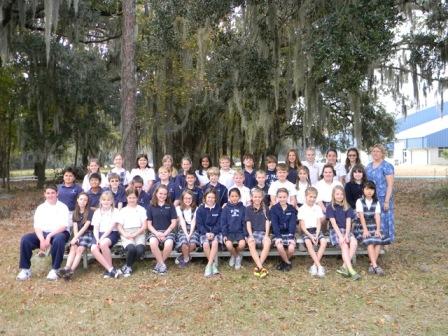 The school has adopted an Integrated Pest Management (IPM) plan. (IPM is a sustainable approach to managing pests by combining biological, cultural, physical, and chemical tools in a way that minimizes economic, health, and environmental risks.) Proper warning signs are posted when pesticides are used.
The school has adopted an Integrated Pest Management (IPM) plan. (IPM is a sustainable approach to managing pests by combining biological, cultural, physical, and chemical tools in a way that minimizes economic, health, and environmental risks.) Proper warning signs are posted when pesticides are used.
The school has also adopted practices that mandate proper labeling, use, storage, and disposal of chemicals, such as cleaning and laboratory chemicals. These practices include, where possible, the reduction in the use of these chemicals.
The campus is very open. Most hallways are outdoors and air circulation is good. Air conditioner units are checked and filters are cleaned monthly. Carpooling is encouraged for team sports by the students as well as for teachers traveling to teacher conferences.


